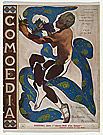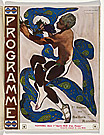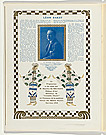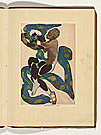L'Après-midi d'un Faune [The Afternoon of a Faun]
Choreographic scene (later choreographic poem)
- Producer: Les Ballets Russes de Serge Diaghilev
- Premiere: 29 May 1912, Théâtre du Châtelet, Paris
- Costume design: Léon Bakst
- Scenery design: Léon Bakst
- Music: Claude Debussy, after the poem by Stéphane Mallarmé
- Choreography: Vaslav Nijinsky
- Main characters: The Faun, nymphs
Opening this ballet, a faun lies on a hillock, idling the afternoon away playing the flute and eating grapes. Seven nymphs, or naiads, approach The Faun’s domain on their way to bathe in a nearby lake. Enchanted by them the faun approaches, causing them to run away. Upon their return The Faun tries again to ingratiate himself with them, causing all but one to flee in fright. The remaining nymph and The Faun flirt with one another until she too leaves in fright, dropping her scarf. The saddened Faun picks it up and returns to the hillock and falls into a reverie over it, ‘consummating’ his desire for the nymph in an orgasmic final gesture.
In his second Greek-themed ballet, Léon Bakst worked closely with choreographer Vaslav Nijinsky to achieve the frozen attitudes of Greek dancers seen in Attic art. He also produced an appropriately layered, darkly glowing Symbolist set design, against which the dancers would posture in their frieze-like positions. The geometric patterns of his earlier costumes for Narcisse are developed and further energised as the dancers create a moving and rippling pattern across the stage. Nijinsky’s choreography exploited this two-dimensionality, eliminating references to traditional ballet technique. The nymphs’ flowing costumes are anchored by almost architectural underskirts in metallic pleated fabric, in deliberate contrast to the sinuous, revealing and animal-like costume worn by Nijinsky as The Faun. The languorous and celebrated musical score for this short ballet was written by Debussy in 1894 and chosen by Diaghilev for the shimmering quality that it laid over Nijinsky’s and Bakst’s visual composition.













